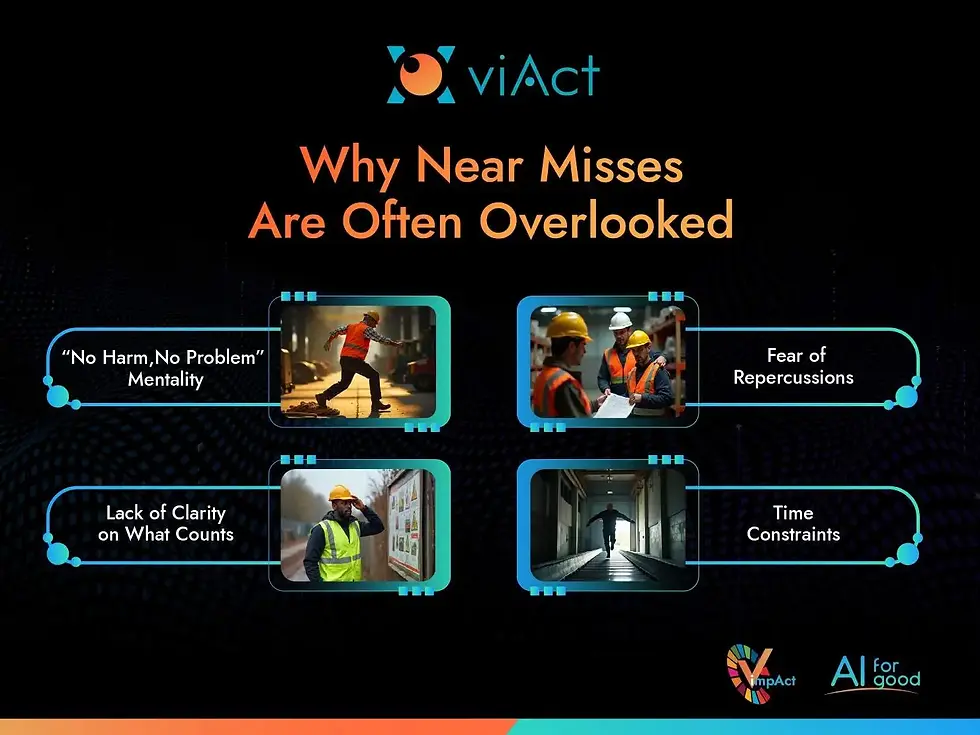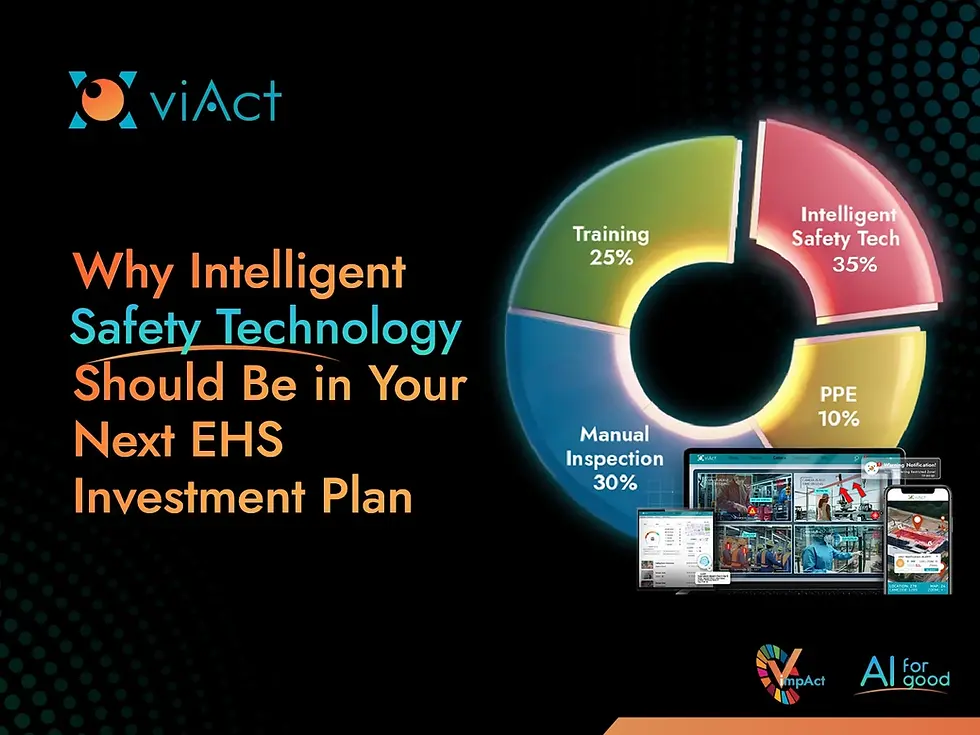How Digital Safety Systems Are Changing the Way We Handle Near Misses
- Shoyab Ali

- Aug 22
- 8 min read
Updated: Sep 25

Workplace safety is often measured by the number of injuries, fatalities, or accidents reported. But what if we’re missing a much bigger piece of the puzzle?
Every EHS professional has heard it:
"That was close."
"Nearly got him."
"Luckily, no one was hurt."
Every day, in high-risk industries across the world like construction, manufacturing, oil & gas, or mining, hazards nearly cause harm but don’t—thanks to luck, quick reflexes, or sheer coincidence. Unfortunately, near misses are often ignored or forgotten because no one was hurt.
In this blog, we discover how traditional systems fall short in near miss reporting, and how technologies like digital safety systems for near miss monitoring endowed with computer vision technology and video analytics are giving us new ways to spot, understand, and act on such close calls before they become costly incidents.
What Is a Near Miss – And Why Does It Matter?
A near miss, also called a close call or near hit, is any unplanned event that could have resulted in injury, illness, property damage, or downtime—but didn’t. Common examples include:
A worker almost slips on a wet floor but regains balance.
A forklift nearly struck a pedestrian in a warehouse.
A falling object lands inches away from a worker.
Even though these events don’t cause harm, they signal the presence of serious risks. The same conditions that led to a near miss today could easily cause a full-blown accident tomorrow.
Why Near Misses Are Often Overlooked
- "A near miss is not a reason to relax; it’s a reason to investigate.”
Despite their importance, near misses are underreported and undervalued globally. Over the years, some specific psychological reasons have emerged as critical:
1. “No Harm, No Problem” Mentality
Since near misses don’t lead to immediate injury or damage, they’re often perceived as less serious or not worth reporting. But this mindset allows dangerous situations to repeat themselves unchecked.
| 2. Fear of Repercussions
In some work environments, employees might worry that reporting a near miss could make them look careless or get them in trouble. This fear discourages the scope of open communication with the supervisor and impacts transparency. |
3. Lack of Clarity on What Counts
Some frontline workers in an industrial setting may not know what qualifies as a near miss. Without proper training and examples, incidents often go unnoticed or unreported. | 4. Time Constraints
In busy job sites, workers may not feel they have the time to report a near miss, especially if the process involves a cumbersome manual undertaking. |
The Hidden Cost of Ignoring Near Misses – Through the Lens of Heinrich’s Safety Pyramid
First introduced in 1931, Heinrich’s Safety Pyramid (also known as Heinrich’s Triangle) has become a foundational model in workplace safety. It proposes a 1:29:300 ratio:
For every 1 major injury, there are typically 29 minor injuries, and 300 near misses or unsafe acts that go unnoticed or unaddressed.
While modern safety professionals may adjust these ratios based on industry data, the concept remains universally applicable. Here’s how ignoring near misses can lead to costly and preventable consequences, especially in industrial settings.
1. Near Misses Are the Base of the Pyramid – and the First Line of Defense
In industrial environments, near misses are alarm bells that don’t yet cost lives, but very soon could. Every unreported or ignored near miss increases the likelihood of escalation. These events highlight process failures—faulty equipment, unclear danger zone signage, or lack of PPE compliance—and offer a chance to intervene before consequences turn critical.
"It’s not the one that hit you—it’s the 300 that nearly did."
2. Unreported Near Misses Reflect Gaps in Safety Culture
Heinrich’s Pyramid is also a mirror to workplace safety culture. Even the National Safety Council (NSC) encourages the establishment of an employee reporting culture when addressing near miss incidents. When the base of the pyramid is filled with unseen or ignored incidents, organizations develop a false sense of safety.
For instance, in a food processing plant in Saudi Arabia, workers regularly bypassed machine guards to speed up operations. Several near misses involving minor cuts, slips, trips & falls, and hand proximity to blades were never formally reported due to fear of reprimand. Eventually, a worker lost a finger, prompting a complete overhaul of training and safety audits.
3. The Operational Cost of Unanalyzed Events
Every near miss is a rehearsal for a future incident, and each one holds valuable data. Ignoring or failing to investigate near misses deprives organizations of low-cost, high-yield learning opportunities. When near misses are analyzed, they provide context-rich examples of what went wrong—whether it's a design flaw, human error, or environmental hazard.
How an AI-Powered Intelligent Safety System Handle Near Misses
The deployment of smart safety systems for workplace near misses indicate the use of artificial intelligence (AI) to automatically analyze footage from existing CCTV or IP surveillance cameras across sites. When analysed with respect to the traditional detection systems, there are many benefits that these safety solutions bring to the sites.
Let’s break down its key advantages:
1. Unbiased Observation
Human eyes in surveillance have limits. EHS teams can get distracted, fatigued, or simply miss things. A thorough footage analysis powered by AI allows safety teams to reconstruct the full timeline of an event—from what preceded it to what followed—offering a more complete picture than human recollection alone.
2. Alerts before “Close Calls”
A growing advantage of using real time video-based systems is their capacity to issue alerts as hazards unfold, allowing for timely intervention rather than retrospective analysis. Imagine a worker unknowingly entering a “Red Zone” while a multi-ton load swaying is just overhead. In a traditional setup, this would go unnoticed until it’s too late. But an AI prompt can halt the crane operations to prevent a serious injury or fatality (SIF).
3. Seeing the Patterns Humans Don’t
AI-driven safety systems for handling near misses doesn’t just act in the moment—it learns over time. By analyzing thousands of hours of footage, these systems can detect trends that even seasoned safety officers might miss. Maybe it’s that certain pathways see more close calls during shift changes, or that forklift-pedestrian near misses tend to spike every Friday evening.
Such patterns, when detected over time, offer evidence-based context for refining shift schedules, workspace layout, or supervision intensity.
4. Turning Real Incidents into Real Lessons
Traditional safety training can sometimes feel like a repetitive loop of same contexts. While interesting posters can fade overtime, manuals gather dust, and staged videos for training purposes rarely feel relevant. But when workers see actual footage of near misses—events that happened on their site, involving their peers—the impact is tenfold.
The video feeds from past incidents, when used thoughtfully and with privacy safeguards for workers, can be repurposed as training material, helping teams learn from what nearly went wrong on familiar ground.
📍 Case Insight: The Messy Maze of Moving Machines
At a manufacturing factory floor in Riyadh, Saudi Arabia, forklifts and floor staff were reporting daily near misses, especially during peak dispatch hours, reversing forklifts popped out of blind storage exits, nearly colliding with workers juggling packing slips and pallets.
Then Came The Watchful Eyes
The EHS team integrated viAct’s AI-powered near miss detection system and suddenly, every risky reversal lit up the radar. The AI caught what humans missed and flagged every “almost-accident” in real time.
- "We finally saw the near misses no one reported,” said the HSE Supervisor, half-relieved, half-stunned.
Reported Results:
|
Building a Safety Culture with EHS Digital Platform That Values Near Misses
To make the most of near miss reporting and analysis, every organisation in the heavy industry sector can follow these best practices:
Promote Open Reporting: No one at work wants to feel like they’re inviting blame. Make it clear that near miss reports are not about finger-pointing—they’re about future-proofing. Using mobile-based reporting mechanisms, the processes can be hassle-free and quick.
Automate Stages with AI: People at work forget details or don’t notice issues at all. AI tools are beginning to bridge the observational blind spots that human monitors often miss, spotting risky behaviors like bypassing barricades or unsafe equipment handling before they lead to harm.
Train Teams to See the Signals: Educate safety teams and workers at all levels on what qualifies as a near miss, why it matters, and how to respond. Incorporate specific near miss experiences into customised training sessions and shift briefings.
Analyze and Act: Use dynamic analytics dashboards, safety heatmaps, and trend lines to identify where, when, and why incidents are likely to occur. Then, discuss findings openly with site teams, incorporate learnings into operational adjustments, and implement corrective measures.
Reframing Near Misses with AI: From Ignored to Investigated
To truly improve workplace safety with AI, EHS leaders and frontline workers must change how they talk and think about near misses.
Instead of: “No harm done.”Say: “We just got lucky—what failed and how can we fix it?”
Instead of: “It was a one-time occurrence.”Say: “Let’s investigate whether this has happened before.”
Instead of: “Just be more careful next time.”Say: “What control failed and how do we prevent this again?”
This shift in language through AI helps promote a proactive safety culture—one that sees near misses not as dismissible, but as opportunities to strengthen systems.
Conclusion: Don’t Let Close Calls Go to Waste
Every near miss is a story—and every story contains a lesson. Choosing to ignore them is like ignoring warning signs on a dangerous road.
Today’s workplaces have the advantage of technology, data, and insight. Emerging technologies like the digital safety platforms for near miss monitoring are providing safety professionals with new ways to observe and interpret near misses, making it possible to act on insights that would have previously gone unnoticed.
But it all starts with a mindset shift: from treating near misses as lucky escapes to treating them as vital sources of truth.
Quick FAQs
1. What types of near misses can safety automation systems detect?
Video analytics for workplace near misses can detect a wide range of near misses—including workers entering danger zones during risky operations, forklifts operating too close to pedestrians, slips and trips near machinery, or unsafe ladder usage.
2. What makes a good near miss detection module?
An effective AI-powered safety monitoring software like viAct should combine contextual awareness (knowing what’s normal and what’s risky), real-time alerting, and pattern recognition over time. The best systems continuously learn from the environment—adjusting for shift patterns, equipment behavior, or seasonal changes—and offer intuitive dashboards that help EHS teams identify where interventions are needed most. Modules that can track motion, posture, object proximity, and behavior anomalies tend to offer the richest insights.
3. What site conditions are needed to implement digital safety systems for near misses?
Basic requirements include:
CCTV/IP cameras with clear visibility of key operational zones
Stable internet or local network connection for continuous streaming
Access to electrical power near monitoring areas
4. Will AI-based smart safety software replace my safety officers?
Not at all. Think of video analytics in near misses detection software as an extra set of eyes, not a replacement:
It helps safety teams catch what human eyes might miss
It reduces manual effort in reviewing footage
It gives inspectors more time to focus on high-risk zones
Humans still make the final call—AI just helps them do it faster and smarter.
5. Where can I find a near miss focused safety monitoring solution?
viAct’s digital platform for near miss safety is available globally and can be deployed across various industrial sites. It currently operates in Hong Kong, Singapore, Saudi Arabia, United Arab Emirates (UAE), Qatar, Oman, Bahrain, Kuwait, and other GCC and Middle East markets, as well as Southeast Asia, Australia, Europe, and North America.
Looking for a Digital Safety System to Handle Near-Misses on Site?
Read More:






Comments